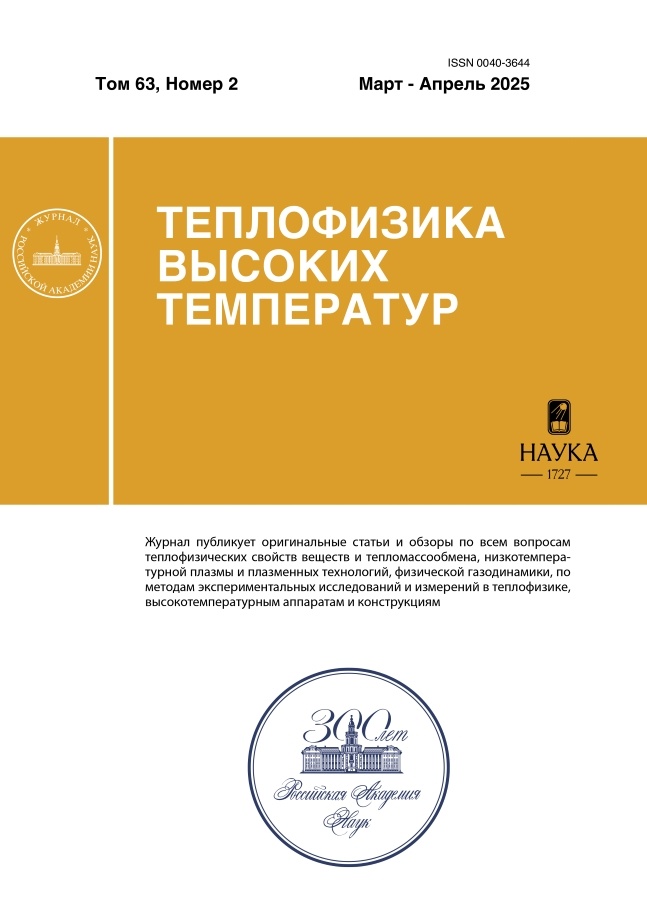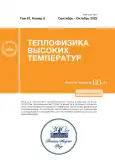Ламинарное пульсирующее течение на начальном участке плоского канала
- Авторы: Валуева Е.П.1, Зюкин В.С.1
-
Учреждения:
- Национальный исследовательский университет “Московский энергетический институт”
- Выпуск: Том 61, № 5 (2023)
- Страницы: 723-729
- Раздел: Тепломассообмен и физическая газодинамика
- URL: https://modernonco.orscience.ru/0040-3644/article/view/653074
- DOI: https://doi.org/10.31857/S0040364423040166
- ID: 653074
Цитировать
Полный текст
Аннотация
Предложен метод решения задачи о пульсирующем квазистационарном течении в канале, основанный на использовании результатов расчета для стационарного течения. Данный подход применим при невысокой относительной частоте колебаний (для чисел Вомерсли меньше единицы). Решение системы стационарных уравнений движения и неразрывности на начальном участке плоского канала проведено методом конечных разностей с помощью итерационной неявной безусловно устойчивой схемы. Исследованы гидродинамические характеристики развивающегося пульсирующего ламинарного течения в плоском канале. Представлены результаты расчетов продольной составляющей скорости, чисел Пуазейля, Эйлера в зависимости от относительной амплитуды колебания средней по сечению скорости А и безразмерной длины канала. Получено, что при значениях А, превышающих единицу, осредненные по периоду коэффициенты гидравлического сопротивления и сопротивления трения вблизи входа в канал значительно выше, чем эти величины при стационарном течении. Показано, что для осуществления пульсирующего течения с большими амплитудами колебаний необходимо создать средний по времени перепад давления примерно в три раза выше (при А = 5), чем для стационарного течения.
Об авторах
Е. П. Валуева
Национальный исследовательский университет “Московский энергетический институт”
Email: ep.valueva@gmail.com
Россия, Москва
В. С. Зюкин
Национальный исследовательский университет “Московский энергетический институт”
Автор, ответственный за переписку.
Email: ep.valueva@gmail.com
Россия, Москва
Список литературы
- Валуева Е.П., Пурдин М.С. Гидродинамика и теплообмен при пульсирующем с большими амплитудами ламинарном течении в каналах // Теплофизика и аэромеханика. 2018. Т. 25. № 5. С. 735.
- Валуева Е.П., Пурдин М.С. Теплообмен при ламинарном течении в прямоугольных каналах // Теплофизика и аэромеханика. 2016. Т. 23. № 6. С. 893.
- Ray S., Ünsal B., Durst F. Development Length of Sinusoidally Pulsating Laminar Pipe Flows in Moderate and High Reynolds Number Regimes // Int. J. Heat Fluid Flow. 2012. V. 37. P. 167.
- Валуева Е.П., Зюкин В.С. Теплообмен на начальном гидродинамическом участке плоского канала с граничными условиями первого рода при ламинарном пульсирующем течении // ТВТ. 2022. Т. 60. № 1. С. 56.
- Валуева Е.П., Гаряев А.Б., Клименко А.В. Особенности гидродинамики и теплообмена при течении в микроканальных технических устройствах. М.: Изд. дом МЭИ, 2016. 138 с.
- Валуева Е.П., Пурдин М.С. Пульсирующее ламинарное течение в прямоугольном канале // Теплофизика и аэромеханика. 2015. Т. 22. № 6. С. 761.
- Bodoia J.R., Osterle J.F. Finite Difference Analysis of Plane Poiseulle and Coutte Flow Developments // Appl. Sci. Res. 1961. V. 10. P. 265.
- Durst F., Ray S., Ünsal B., Bayoumi O.A. The Development Lengths of Laminar Pipe and Channel Flows // ASME J. Fluids Eng. 2005. V. 127. P. 1154.
- Joshi Y., Vinoth B.R. Entry Lengths of Laminar Pipe and Channel Flows // J. Fluids Eng. 2018. V. 140. № 6. P. 061203.
- Atkinson B., Brocklebank M.P., Card C.H., Smith J.M. Low Reynolds Number Developing Flows // AlChE J. 1969. V. 15. № 4. P. 548.
Дополнительные файлы














